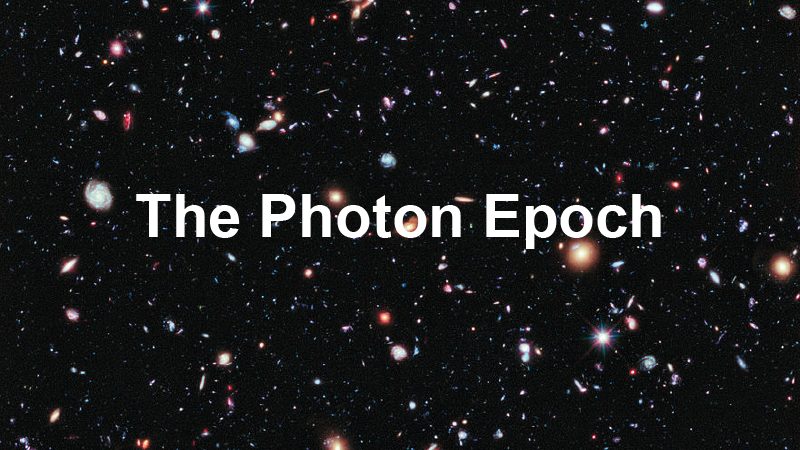The Photon Epoch
Episode #3 of the course A short history of the universe
From one to ten seconds after the Big Bang, the universe was filled with leptons and anti-leptons (such as electrons and positrons) as energies were still high enough to create them as fast as they destroyed each other. But at 10 seconds after the Big Bang, the universe became too cool to create them out of the radiation (light) that still filled space at this time. Most of the leptons and anti-leptons that were there annihilated each other, leaving only the leftover leptons that we still have today. Meanwhile, the mutual annihilation of all that matter and anti-matter created many high-energy gamma photons which then dominated the universe—for 377,000 years!
At the beginning of this epoch, the universe was completely filled with a fluid-like plasma made of photons, protons, neutrons, electrons, and neutrinos. At first it was too hot for nuclear fusion to occur! Protons and neutrons were constantly hitting each other, but they had so much energy that they would either destroy each other completely in a burst of radiation or bounce off.
Then, around the end of the first minute, the universe cooled down enough for fusion to occur, with protons and neutrons binding together to form deuterium and tritium (heavy isotopes of hydrogen nuclei consisting of one proton plus one or two neutrons), and then helium nuclei (with two protons and two neutrons) and even a small proportion of lithium and beryllium nuclei. This period of “nucleosynthesis” lasted only a few minutes, and by the end of it, most of the hydrogen and helium nuclei that the universe would ever contain had been created!
Hydrogen has been the most common element in the universe since nucleosynthesis ended a few minutes after the Big Bang, with about 75% of the matter in the universe in hydrogen nuclei (protons), 24% in helium nuclei, and 1% everything else (not counting dark matter). None of the heavier elements, such as the carbon, oxygen, and nitrogen that make up our bodies, would exist until they were created by fusion in the cores of stars some millions of years after the Photon Epoch.
There was one other interesting timestamp in the middle of the Photon Epoch. Up until about 70,000 years after the big band (ya), the energy density of radiation was greater than the energy density of matter throughout the universe, which determines how fast space-time is expanding. But around 70,000 ya, the universe became large enough that the density of radiation dropped below the density of matter, and the “matter-dominated” era of the universe began and would last for billions of years—until around the time our solar system formed, when the density of matter in the universe dropped low enough for the effects of dark matter and energy to dominate the expansion of space-time. But that’s another lesson!
Recommended book
“The Accidental Universe: The World You Thought You Knew” by Alan Lightman
Share with friends

